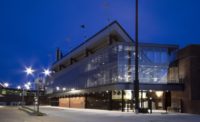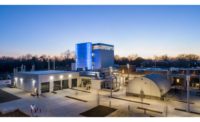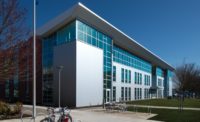There is a new generation of glass façades, and the innovation in aesthetics and functionality has evolved quickly over the past few years. Architects now have more choices, taking into consideration light transmission, solar shading, and thermal performance, among other things, while also delivering the proper visual result for each client. It’s like going to the 24-hour diner and reading the 40-page menu: all of the choices may look appealing, but there’s only one right one for the occasion.
The team at BNIM Architects faced its own façade dilemma on a project that opened last year at Johnson County Community College in Overland Park, Kansas. In the construction of JCCC’s new Fine Arts & Design Studio, architects needed to find a façade that delivered aesthetically and met the needs of the growing university.
They chose a new type of specialty glass called Lumi Frit by New Jersey-based architectural glass supplier Bendheim. The Surface 1 fritted glass reflects sunlight during the day to a luminous, ultra-white effect, and is projectable at night. Installed in the company’s proprietary “clip-in” ventilated glass cladding system, it enlivens the façade as the sun tracks across the sky.
“The building and its spaces exemplify the notion of learning by doing, providing a framework for new synergies and enhanced collaboration across disciplines that were previously dispersed across campus,” said AIA Kansas City, which gave BNIM a merit award for the project. “In addition to providing flexible and vibrant interior studios, the building is thoughtfully sited to provide intimately scaled exterior spaces for the creation and display of art.”
Projectable Glass
Perhaps the most unique aspect of the $19.2 million project is the glass façade. It covers 3,800 square feet with 153 glass panels that measure 40 inches by 88 inches each.
According to a Bendheim press release, the custom Lumi Frit glass at JCCC features a fine white dot pattern on surface #1, laminated to SatinTech etched glass, to create a strong light-diffusing effect. Behind the 170-foot-wide translucent glass façade, second-story windows fill the studios with soft, glare-free daylight. The glass façade is also designed so that it can double as a projection screen for student art, eventually transforming into a lit canvas.
“The projectable façade idea was a product of project exploration and collaborative design,” said John Collier, Associate Principal for BNIM. The architects chose the Lumi Frit surface in consultation with the college, which loved the idea of being able to project information about upcoming events and exhibits, as well as student work.
“Surface one frit glass is rare due to the technical challenges of producing a colored glass surface that can be exposed to the elements,” stated Bendheim. The Lumi Frit surface does have numerous benefits, however. The Surface 1 dot/mesh pattern allows for images to be projected on the glass façade. It also minimizes reflections from the glass, making patterns more pronounced and easier to read from a distance. This helps highlight the pattern, and is especially desirable when custom designs are used.
Among the main reasons for choosing Lumi Frit glass for this project, it lends the façade a brilliant ultra-white appearance, as daylight reflects off the fritted glass surface. “Instead of being in the shadow, it actually glows,” said John Collier, AIA, Associate Principal at BNIM. “It is interesting because it becomes a lighting element on the north face of the building, which normally would be in the shadow.”
The glass also becomes more easily visible to birds by interrupting continuous reflections. When the frit pattern is designed by the “2 x 4” bird-friendly rule, it is extremely effective in minimizing bird strikes. Architects are installing bird-friendly glass on more projects, and in some cases, are being required to do so by law. About 253 billion birds die each year due to collisions with buildings, according to the American Bird Conservancy.
Like many façades and materials now available to architects, Lumi Frit is available in an unlimited range of patterns and can reach sizes up to 7 feet across and 13.75 feet in length.
Clip-In System
Another advantage of the design was the unique “clip-in” cladding system. It helped expedite fabrication and installation. The clips, which can be used for interior and exterior applications, are simple to install and do not require any special training or expertise. They can be affixed to steel, aluminum, timber, or other substructures. They are supplied in a standard silver powder-coated finish or hundreds of custom colors, and do not require special maintenance. JPI Glass of Kansas City, Missouri, installed the glass.
The system helps create clean, crisp corners and a streamlined box appearance. The ventilated glass façade is also offset 10 feet from the windows, allowing additional indirect sunlight into the building.
The new building also includes magnetic glass dry-erase boards from Bendheim, which provide durable glass surfaces for instruction, brainstorming, and idea-sharing.
Celebrating Milestones
The new building helped celebrate the 50th anniversary of Johnson County Community College, which has an enrollment of more than 44,000 students and is the largest among the state’s 19 community colleges.
Prior to the new building, visual arts students shared instructional space in the school’s Arts & Technology building, alongside students studying welding, automotive, and electrical technology. “In the old space we really did great things,” Mark Cowardin, chair of JCCC’s fine arts, photography and film department, said in an article published by KC Studio. “But we were too tight. Here we’ll have designated space for each discipline.”
The new 41,000-square foot building includes studios, labs, offices, a library, a student lounge, and support spaces. Student art projects are showcased throughout the shared spaces. Approximately 3,000 students, pursuing everything from photography to film to graphic design to fine arts, now have the elbow room to develop their ideas.
The project delivers perfectly on its intent. Its unique Bendheim façade helps introduce an artistic component into the structure.
“In the fine arts are these silos of specialties, but the trend is to break through those silos,” Cowardin said. “We are encouraging a creativity zone where we can build our reputation and present to our students the opportunity for innovation.”





